Organic Chemistry Some Basic Principles and Techniques Chemistry Chapter 12
• Organic Chemistry
Organic chemistry is the branch of chemistry that deals with the study of hydrocarbons and their derivatives.
The Shapes of Carbon Compounds:
In organic or carbon compounds, s and p orbitals are involved in hybridisation. This leads to y three types of hybridisation which are sp
3
(in alkanes) – Tetrahedral in shape sp
2
(in alkenes) – Planar structure sp(in alkynes) – Linear molecule
Functional Group:
The functional group are atom or group of atoms joined in a specific manner which determines the chemical properties of the organic compound. The examples are hydroxyl group (—OH), aldehyde group (—CHO) and carboxylic acid group (—COOH) etc.
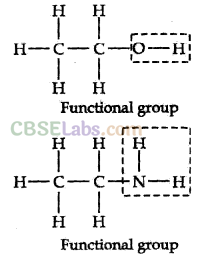
• Homologous Series
A homologous series may be defined as a family of organic compounds having the same functional group, similar chemical properties and the successive members differ from each other in molecular formula by —CH2 units.
The members of a homologous series can be represented by same general molecular formula.
• Nomenclature of Organic Compounds
Common name (Common system):
Before the IUPAC system of nomenclature, organic compounds were named after the sources of origin, for example, urea was so named because it was obtained from the urine of mammals. Formic acid was so named since it was extracted from red ants called formica.
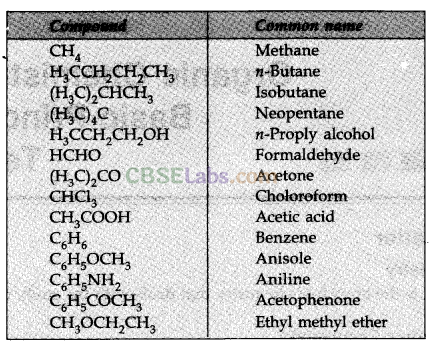
• I UP AC (International Union of Pure and Applied Chemistry) System
According to IUPAC system, the name of an organic compound contains three parts: (i) word root, (ii) suffix, (iii) prefix.
(i) Word root:
Word root represents the number of carbon atoms present in the principal chain, which is the longest possible chain of carbon atoms.

(ii) Suffix:
Suffix are of two types, primary suffix, secondary suffix.
(a) Primary Suffix: It indicates the type of bond in the carbon atoms.

(b) Secondary Suffix: Secondary suffix is used to represent the functional group.
(iii) Prefix:
Prefix is a part of IUPAC name which appears before the word root. Prefix
are of two types:
(a) Primary prefix: For example, primary prefix cyclo is used to differentiate cyclic compounds.

(b) Secondary prefix: Some functional groups are considered as substituents and denoted by secondary prefixes.
For example:
Substituted Group Secondary prefix.
— F Flupro
— Cl Chloro
— Br Bromo
— NO Nitroso
— NO
2
Nitro
— CH
3
Methyl
— OCH
3
Methoxy
Naming of Compounds Containing Functional Groups:
The longest chain of carbon atoms containing the functional group is numbered in such a manner that the functional group is attached at the carbon atoms possessing lowest possible number in the chain.
In case of polyfunctional compounds, one of the functional group is selected as principal functional group and the compound is named on that basis. The choice of principal functional group is made on the basis of order of preference.
The order of decreasing priority for the functional group is

• Isomerism
When there are two or more compounds possessing the same molecular formula but different structural formula and different physical and chemical properties, the phenomenon is called isomerism. Such compounds are called isomers.
It is of two types:
(1) Structural Isomerism
(2) Stereoisomerism
(1) Structural Isomerism: Structural isomerism is shown by compounds having the same molecular formula but different structural formulae differing in the arrangement of atoms.
(2) Stereoisomerism: When isomerism is caused by the different arrangements of atoms or groups in space, the phenomenon is called stereoisomerism. The steroeoisomers have same structural formula but differ in arrangement of atoms in space. Stereoisomerism is of two types:
(i) Geometrical or Cis-Trans Isomerism
(ii) Optical Isomerism
• Fundamental Concepts in Organic Reaction Mechanism
Fission of a covalent bond: A covalent bond can undergo Fission in two ways:
(i) By Homolytic Fission or Homolysis
(ii) By Heterolytic Fission or Heterolysis
Homolytic Fission:
In this process each of the atoms acquires one of the bonding electrons.

Heterolytic Fission:
In this process one of atoms aquires both of the bonding electrons when the bond is broken.
If B is more electronegative than A which thereby aquires both the bonding electrons and becomes negatively charged.
![]()
The products of heterolytic fission are ions.
Reaction Intermediates:
Heterolytic and homolytic bond fission results in the formation of short-lived fragments called reaction intermediates. Among the important reaction intermediates are carbonium ions, carbanions, carbon free radicals and carbenes. Carbonium Ions (carbocations): Organic ions which contain a positively charged carbon atom are called carbonium ions or carbocations. They are formed by heterolytic bond fission.

where Z is more electronegative than carbon.
Tertiary carbonium ion is more stable than a secondary, which in turn is more stable than a primary because of +1 effect associated with alkyl group.
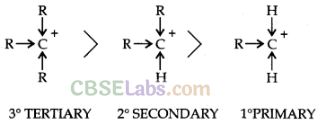
Carbanion:
Organic ion which contains a negatively charged carbon atom are called carbanions. They are also formed by heterolytic bond fission.

Where Z is less electronegative than carbon. A primary carbanion is more stable than a secondary, which in turn is more stable than a tertiary, because of +1 effect associated with alkyl group.

Electrophile:
It is positively charged or neutral species which is electron deficient, e.g.,
He
–
, H
2
0
+
, CH
3
, NH
4
+
, AICl
3
, S0
3
, CHCl
2
, CCI
3
.
Nucleophile: It is negatively charged or neutral species with lone pair of electrons e.g., (HO
–
), Cyanide (C = N), H
2
0: R
3
N, R
2
NH etc.
Electron Displacement Effects in Covalent Bonds:
Electronic displacements in covalent bonds occurs due to the presence of an atom or group of different electronegativity or under the influence of some outside attaching group.
These lead to a number of effects which are as follows:
(i) Inductive effect (ii) Elecromeric effect
(iii) Resonance or Mesomeric effect (iv) Hyperconjugation effect.
Inductive Effect:
It involues c electron. The a electrons which form a covalent bond are seldom shared equally between the two atoms. Due to different electronegatively electrons are displaced towards the more electronegative atom.
This introduces a certain degree of polarity in the bond.
The more electronegative atom acquires a small negative charge (δ
–
). The less electronegative atom acquires a small positive charge (δ
+
).
Consider the carbon-chlorine bond
As chlorine is more electronegative, it will become negatively charged with respect to the carbon atom.

Structure I- indicates the relative charges on the two atoms.
Structure II- indicates the direction in which the electrons are drawn.
Atoms or groups which lose electrons towards a carbon atom are said to have a +1 effect. Those atoms or groups which draw electrons away from a carbon atom are said to have a -I Effect.
Some common atoms or groups which cause +I or -I effects are shown below:

The inductive effect of C
3
upon C
2
is significantly less than the effect of the chlorine atom on C.
Resonance Structure:
A number of organic compounds cannot be accurately represented by one structure.
For example, benzene is ordinarily represented as

Carbon-carbon double bond length = 1.34 A
Carbon-carbon single bond length = 1.54A. But it has been determined experimentally that all carbon-carbon bonds in benzene are identical and have same bond length (1.39A).
Thus the structure of benzene cannot be represented by single structure. It can be represented equally well by ‘he energetically similar structures I and II. The two structures are called resonance structures.

Actual structure of benzene is resonance hybrid of structures I and II.
Another example of resonance is provided by nitromethane (CH
3
N0
2
) which can be represented by two Lewis structures.

The actual structure of nitromethane is a resonance hybrid of the two canonical forms I and II. Resonance energy: The difference in the energy between the most stable contributing structure for a compound and its resonance hybrid is called as resonance energy or resonance stabilisation energy.
Resonance Effect:
The polarity produced in the molecule by the interaction of two π-bonds or between a π-bond and a lone pair of electrons present on an adjacent atom. There are two types of resonance or mesomeric effects designated as R or M effect.
Positive Resonance Effect (+R effect):
Those atoms which lose electrons towards a carbon atom are said to have a +M effect or +R effect. For example:
—Cl, —Br, —I, —NH
2
, —NR
2
, —OH, —OCH
3
Negative Resonance Effect (-R effect):
Those atoms or groups which draw electrons away from a carbon atom are said to have a -M effect or -R effect.
For example:
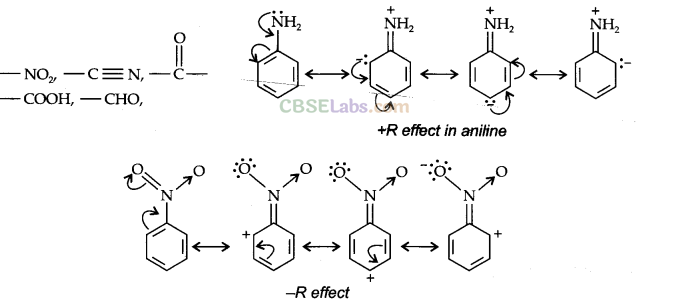
Electromeric Effect (E Effect):
The electrom’eric effect refers to the polarity produced in a multiple bonded compound when it is attacked by a reagent when a double or a triple bond is exposed to an attack by an electrophile E
+
(a reagent) the two π electrons which from the π bond are completely transferred to one atom or the other. The electromeric effect is represented as:
![]()
The curved arrow shows the displacement of the electron pair. The atom A has lost its share in the electron pair and B has gained this share. Therefore A acquires a positive charge and B a negative charge.
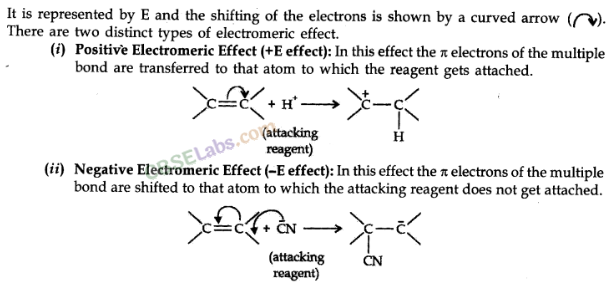
Hyperconjugation or No Bond Resonance: When the alkyl group is attached to an unsaturated system such as —CH=CH
2
group the order of inductive effect gets reversed. The behaviour can be explained by hyperconjugation effect.
Such structures are arrived at by shifting the bonding electrons from an adjacent C —H bond to the electron deficient carbon. In this way, the positive charge originally on carbon is dispersed to the hydrogen.
This way of electron release by assuming no bond character in the adjacent C—H bond is called No-Bond Resonance or Hyperconjugation.

• Orbital Concept of Hyperconjugation
It involues delocalisation of o electrons of C—H bond of an alkyl group which is attached directly to an atom of unsaturated system or to an atom with an unshared p-orbital.
Let us consider CH
3
CH
2
(ethyl cation) in which the positively charged carbon atom has an empty p-orbital. One of the C—H bonds of the methyl group can align in the plane of this empty p-orbital and electron constituting the C—H bond in plane with this p-orbital can then be delocalised into the empty p-orbital as in Fig.
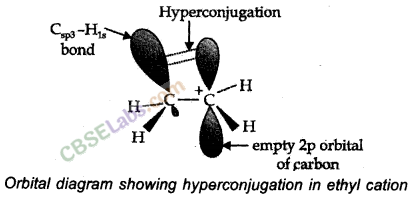
In general, greater the number of alkyl groups attached to a positively charged carbon atom, the greater is the hyperconjugation.
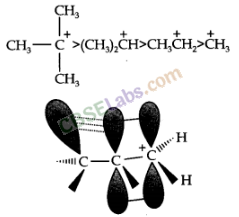
• Qualitative Analysis of Organic Compounds
Detection of Carbon and hydrogen: Put Copper Oxide Test:
The organic substance is mixed intimately with about three times its weight of dry copper oxide. The mixture is then placed in a hard glass test-tube fitted with a bent delivery tube. The other end of which is dipping into lime water in another test tube.
The mixture is heated strongly and the following reactions take place.

Thus if carbon is present it is oxidised to carbon dioxide which turns lime water milky. If hydrogen is also present, it will be oxidised to water droplets on the cooler wall of the test tube.
Detection of other elements
Lassaigne’s test:
Nitrogen, sulphur, halogens and phosphorus present in an organic compound are detected by ‘Lassaigne’s test’. Covalent compounds are converted into ionic form by fusing the compound with sodium metal. Following reaction occurs:

Test for Nitrogen:
(i) The substance is heated strongly with sodium metal.
Na + C + N ———–> NaCN
(ii) The water extract of the fused mass is boiled with ferrous sulphate solution

(iii) To the cooled solution is then added a little ferric choride solution and excess of concentrated hydrochloric acid.
![]()
The formation of prussian blue or green colouration confirms the presence of nitrogen.
Test for sulphur:
Sodium Test:
Sulphur, if present, in the given organic compound, upon fusion with sodium reacts to form sodium sulphide

Thus the sodium extract obtained from the fused mass is tested as:
(i) Add freshly prepared sodium nitroprusside solution. A deep violet colouration indicates sulphur.
(ii) Acidify the portion of the extract with acetic acid and then add lead acetate solution. A black precipitate of lead sulphide confirms the presence of sulphur.

If nitrogen and sulphur both are present in an organic compound, sodium thiocyanate is formed. It gives blood red colour and no prussian blue since there are no free cyanide ions.

Test for Halogens
Sodium Test: Upon fusion with sodium, the halogens in the organic compound are converted to sodium halides.
Cl + Na ——-> NaCl
Br + Na ———> NaBr
I + Na ———>NaI
Acidify a portion of ‘sodium extract’ with dilute nitric acid and add to it silver nitrate solution. White ppt. soluble in ammonia indicates Chlorine.
Yellow ppt. sparingly soluble in ammonia indicates Bromine.
Yellow ppt. insoluble in ammonia indicates Iodine.
When nitrogen or sulphur is also present in the compound, the sodium extract before testing for halogens is boiled with strong nitric acid to decompose the cyanide and the sulphite formed during the sodium fusion. If not removed, these radicals will form a white and black precipitate respectively on the addition of silver nitrate.

Test for phosphorous
The compound is heated with an oxidising agent (sodium peroxide). The phosphorous present in the compound is oxidised to phosphate.
The solution is boiled with HN0
3
and treated with ammonium molybdate. A yellow coloured ppt. indicates the presence of phosphorous.

• Quantitative Analysis
Estimation of Carbon and Hydrogen
Both carbon and hydrogen are estimated together in one operation. A known weight of an organic compound is burnt in the presence of excess of oxygen and copper (II) oxide. Carbon and hydrogen are oxidised to carbon dioxide and water respectively.
![]()
The weight of carbon dioxide and water thus formed are determined and the amounts of carbon and hydrogen in the original substance calculated.
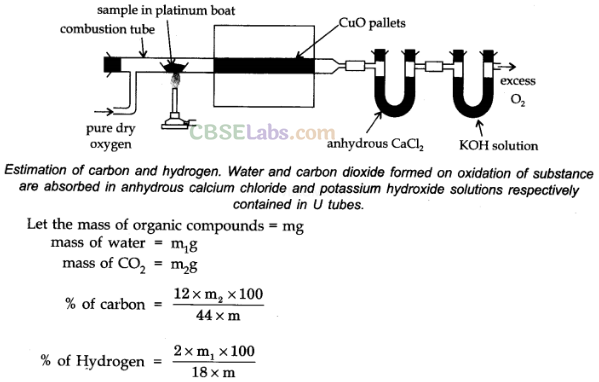
Estimation of Nitrogen
(i) Dumas method:
This method is based on fact that the nitrogenous compounds when heated with copper oxide in an atmosphere of carbon dioxide yield free nitrogen,
![]()
The traces of oxides of nitrogen, which may be formed in some cases, are reduced to elemental nitrogen by passing over heated copper spiral.
Apparatus can be shown as:
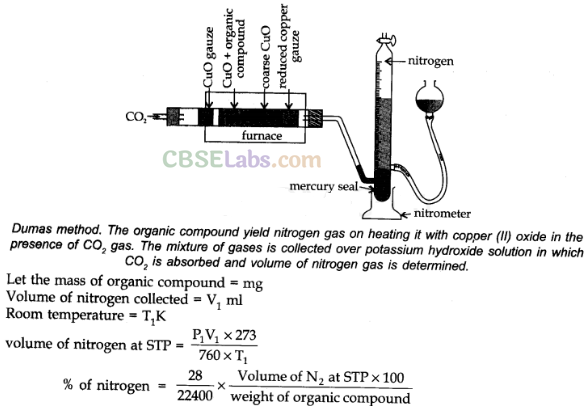
(ii) Kjeldahl’s Methods:
Kjeldahl’s method is based on the fact that when an organic compound containing nitrogen is heated with con. H
2
S0
4
the nitrogen in it is converted to ammonium sulphate. The resultant liquid is then treated with excess of alkali and the liberated ammonia gas absorbed in excess of standard acid. The amount of ammonia is determined by finding the amount of acid neutralised by back filtration with some std. alkali.
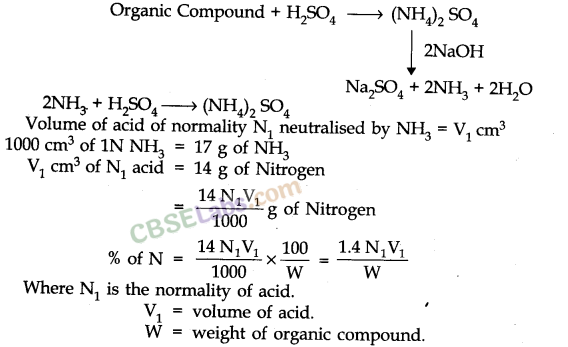
• All organic compounds contain carbon and hydrogen as essential constituents.
• In a homologous series two successive members differ in their molecular formula by -CH
2
unit.
• Aliphatic Compounds are open chain compounds contain straight or branched chain of carbon atoms.
• Alicyclic Compounds:
Compounds containing closed ring of carbon compounds.
• Aromatic Compounds
: Benzene and its derivatives are called aromatic compounds.
• Functional group:
A functional group is an atom or group of atoms bonded together in a unique fashion and which determines the physical and chemical properties of the compounds.
• Homolytic Bond Fission:
It leads to the formation of free radicals.
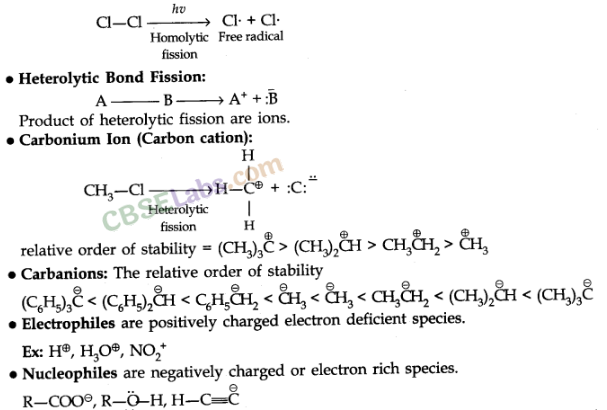
• Crystallisation is used to purify organic solids by dissolving them in suitable solvents.
• Simple distillation is used to purify liquids with non-volatile impurities.
• Steam distillation is used to purify organic compounds which give sufficient vapours at the boiling of water and are insoluble in water.
• Chromatography is used to purify and separate the constituents from a sample.
• Lassaigne’s test is used to detect carbon, nitrogen, sulphur and halogen in organic compound.
• Dumas or Kjeldahl’s method:
Nitrogen is estimated by this method.
• Halogens:
Halogens are estimated by Carius method.
• Sulphur and phosphorous:
Sulphur and phosphorous are estimated by oxidising them to sulphuric and phosphoric acid respectively.
• Oxygen:
The percentage of oxygen is usually determined by difference between the total percentage (100) and the sum of the percentages of all other elements present.